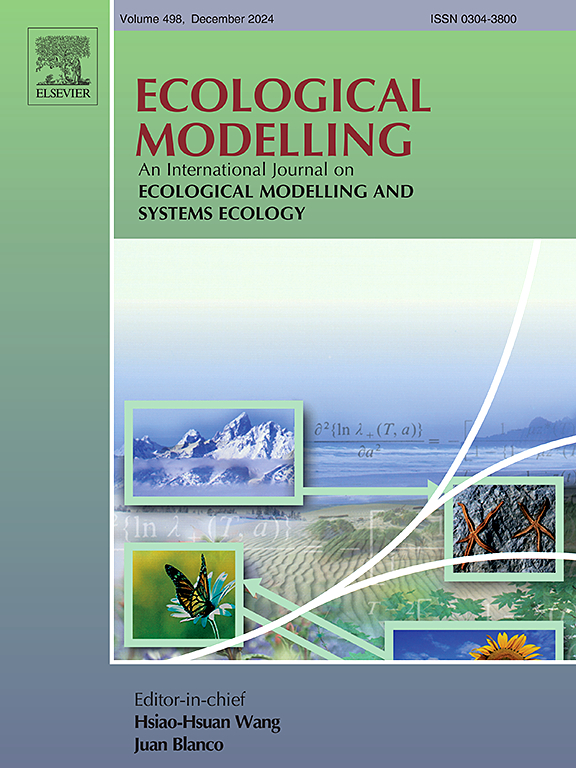When can few-species models describe dynamics within a complex community?
IF 2.6
3区 环境科学与生态学
Q2 ECOLOGY
引用次数: 0
Abstract
Dynamics of species’ abundances in ecological communities are often described using models that only account for a few species. It is not clear when and why this would be possible, as most species form only a part of diverse ecological communities, with many species that are not included in these few-variable descriptions. We study theoretically the circumstances under which the use of such models is justified, by considering the dynamics of a small set of focal species embedded within a diverse, sparsely-interacting community. We find that in some cases many species fluctuate chaotically and a few-variable description becomes impossible. Yet in other cases, where the abundance fluctuations are concentrated on the focal species and those close to them on the interaction network, we show that such a description exists, even when the interactions with the surrounding community are not weak, and its effect on the focal species’ dynamics is nontrivial. We show that in many cases the time-dependent abundances of the focal species can be well-described by dynamical equations that explicitly model only the focal species abundances, with the effect of the surrounding community incorporated merely by changing the model parameters to effective ones. We give two different methods for achieving this, cast as approximations that become exact in two different regimes, depending on the focal species and their relation to the rest of the community. Both methods work surprisingly well in many of the cases that we check, with effective dynamics that are often very similar and sometimes indistinguishable from the true dynamics, even when the effect of the community on the focal species is significant.
什么时候少物种模型可以描述一个复杂群落的动态?
生态群落中物种丰度的动态通常用只考虑少数物种的模型来描述。目前尚不清楚何时以及为什么这是可能的,因为大多数物种只形成了多样化生态群落的一部分,许多物种不包括在这些少数变量的描述中。我们从理论上研究了在何种情况下使用这些模型是合理的,通过考虑嵌入在一个多样化的、稀疏相互作用的群落中的一小组焦点物种的动态。我们发现,在某些情况下,许多物种的波动是混乱的,很少的变量描述变得不可能。然而,在其他情况下,当丰度波动集中在焦点物种及其附近的相互作用网络上时,即使与周围群落的相互作用不弱,这种描述也是存在的,并且它对焦点物种动态的影响是非微不足道的。我们发现,在许多情况下,焦点物种的时变丰度可以用动力学方程很好地描述,该方程明确地只模拟焦点物种的丰度,而仅仅通过将模型参数更改为有效参数就可以将周围群落的影响纳入其中。我们给出了两种不同的方法来实现这一目标,根据焦点物种及其与社区其他物种的关系,在两种不同的制度下,作为精确的近似值。在我们检查的许多情况下,这两种方法的效果都非常好,有效动态通常与真实动态非常相似,有时甚至无法区分,即使群落对焦点物种的影响很大。
本文章由计算机程序翻译,如有差异,请以英文原文为准。
求助全文
约1分钟内获得全文
求助全文
来源期刊

Ecological Modelling
环境科学-生态学
CiteScore
5.60
自引率
6.50%
发文量
259
审稿时长
69 days
期刊介绍:
The journal is concerned with the use of mathematical models and systems analysis for the description of ecological processes and for the sustainable management of resources. Human activity and well-being are dependent on and integrated with the functioning of ecosystems and the services they provide. We aim to understand these basic ecosystem functions using mathematical and conceptual modelling, systems analysis, thermodynamics, computer simulations, and ecological theory. This leads to a preference for process-based models embedded in theory with explicit causative agents as opposed to strictly statistical or correlative descriptions. These modelling methods can be applied to a wide spectrum of issues ranging from basic ecology to human ecology to socio-ecological systems. The journal welcomes research articles, short communications, review articles, letters to the editor, book reviews, and other communications. The journal also supports the activities of the [International Society of Ecological Modelling (ISEM)](http://www.isemna.org/).
 求助内容:
求助内容: 应助结果提醒方式:
应助结果提醒方式:


